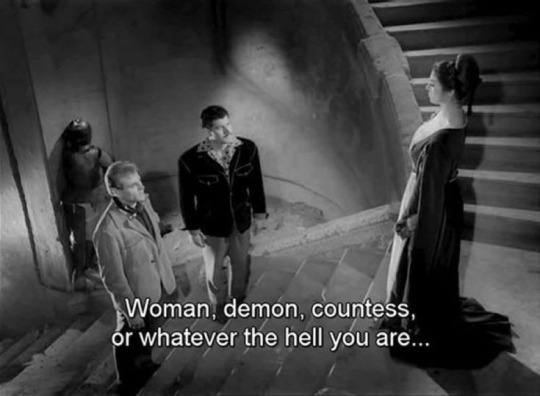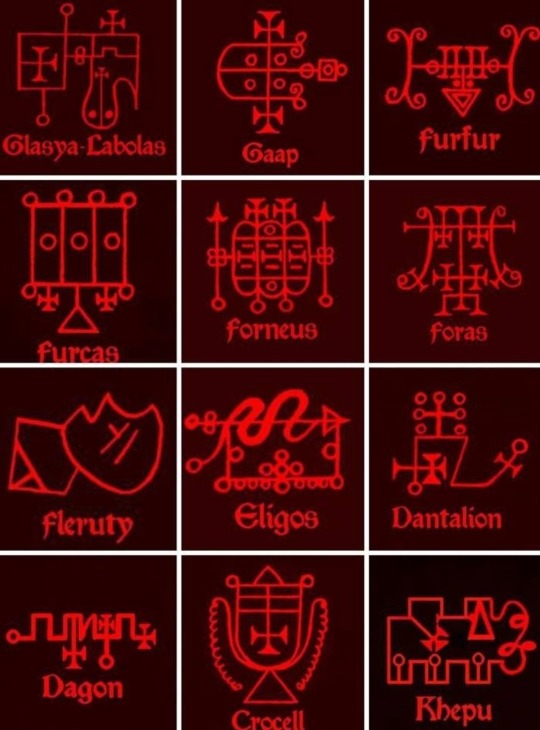#satanic magic
Explore tagged Tumblr posts
Text

38 notes
·
View notes
Text
The Satanic Bible, by Anton LaVey

Title: The Satanic Bible
Author: Anton Szandor LaVey
Publisher: William Morrow Paperbacks
Publishing Date: December 1, 1969 (First Edition)
ISBN-10: 0380015390
ISBN-13: 978-0380015399
Alright, let's start with the elephant in the room. This little book is often the only thing people read on Satanism, and for good reason - it made quite a splash when it was published.
Considered the foundational text of the Church of Satan and their specific style of atheistic Satanism (often called LaVeyan Satanism), The Satanic Bible is part philosophy, part religious teaching, and part magical instruction. LaVey is well known for his stance that humanity does not need God, and that believing in God (or Satan, for that matter) as real entities serves only to hold back our potential. However, LaVey argues that humanity does need religion, and that religion requires dogma and ceremony. The dogma and ceremony LaVey offers to the reader is based on one's own happiness and self-satisfaction, as opposed to the Christian values of self-sacrifice for the greater good. His Nine Satanic Statements, Eleven Satanic Rules of the Earth, and Nine Satanic Sins are easy to read and understand, and seem to be the inspiration for other Satanist's lists of values, such as The Satanic Temple's Seven Fundamental Tenants.
LaVey embraces sexuality and indulgence, framing sexual energy as the best and most potent source of power for magical workings. Magic is described not as an appeal to a higher power but a seizing of one's own fate, aiming for success and happiness through the manipulation of the world around oneself. The practices he recommends are rooted in ceremonial magic, especially Enochian magic.
The Satanic Bible has had multiple editions and translations since its original publication and is widely available through most online book retailers, as well as sometimes being stocked in magical and metaphysical shops.
[DISCLAIMER: The Devil's Library is not affiliated with any of the previously mentioned groups or authors. It is an independent project by a single Satanist. Do not mistake my mentioning of an author or group as endorsement for their beliefs and practices.]
Beneath the cut you'll find my personal review and opinions on this book.
I've said before on this blog that I am not LaVeyan, and that's still true. While I greatly respect the concept of a non-theistic religion and I lift my glass to all those who work hard to form such religions, I prefer a theistic view of the world. On top of that, LaVey's philosophy does little for me. In truth I consider LaVey's work to not be particularly revolutionary in terms of philosophy. He was a self-admitted fan of Ayn Rand and his brand of Satanic individualism has oft been compared to Randian philosophy with a coat of occult paint slapped on top - I think that evaluation holds true. His magical system also strikes me as unoriginal, given he simply reworked the Enocheon keys. My overall evaluation of the man was that he was a lazy philosopher and a lazy magician, but a skilled showman, and that's how he pulled in as many followers and critics as he did. People were rejecting God and practicing ceremonial magic long before LaVey came along. He just cultivated a compelling aesthetic around it.
I think it's safe to say the book is a product of its time and creator. LaVey is both progressive and regressive, endorsing kink and queer sexuality while also objectifying women in his magical practice (LaVey is, as far as I can tell, the originator of the Satanic tradition of using a nude woman's body as an altar, and he makes a note that during ritual, men should wear robes, but women should dress scantily in order to titillate the men) and having some deep misunderstandings about asexuality. It's also not to be taken lightly that while as far as I'm aware, LaVey himself didn't profess to be a white supremacist, his fondness for Ayn Rand shows a fondness for fascism, he certainly rubbed elbows with white supremacists, and various individuals and groups that broke off from the original Church of Satan have been noted as having a range of Nazi-adjacent views and values, namely the Temple of Set. His list of "Satanic names" is also a very sloppily cobbled together list of names of any god, deity, or spirit who's ever been even slightly associated with negativity, utterly ripped from their cultural context and reduced to keywords that, I assume, LaVey expects the readers to either claim as names of their own or use in rituals. The list includes outright racist cultural appropriation, such as the inclusion of Kali's name, to ignorant misrepresentations of myth, such as calling Loki the "Teutonic devil." As always, I recommend referencing scholarly and culturally conscious resources when it comes to discussions of other religions and mythologies. Do not take a single writer with no credentials at face value.
That being said this is a book I generally recommend people read, with the added note that taking it entirely at face value and assuming it's the one true Satanic text is a mistake. The Satanic Bible is integral to our religious history at this point, but we need not cling to it as entirely or even mostly correct. It is also useful to be familiar with it when interacting with other Satanists, as it's possibly the most commonly read book in the entire religion, so like it or hate it, you probably should have some opinion on it.
#satanism#atheistic satanism#the satanic bible#anton lavey#laveyan satanism#satanic magic#the devil's library#the devils library#tdl#bookshelf#my posts
58 notes
·
View notes
Text




I wanted to do a public praise and thanks-giving post to Duchess Bune ✨
She really helped me to solve my financial problems, to present myself as a more charming and persuading individual, and she accompanied me on the buying process of our new home. I must really thank Her for her help
I really reccomend working with Bune if you need to improve yourselves at all levels. But you must work hard and persevere
#brujas of tumblr#witchywoman#goetia#goetic demons#duchess bune#bune#solomonic magic#evocation#invocation#demonology#demonolatry#satanic magic#goetia demon#bune goetia#daimon#daimons#thank you#thanksgiving#deity devotion#demon devotion#rituales#magic ritual#paganblr#cosas de brujas
32 notes
·
View notes
Text
Into the Devil’s Den and Back: Four Lectures by Magister Carl Abrahamsson
Into the Devil’s Den and Back: four lectures on LaVey and Satanism by Magister Carl Abrahamsson Into the Devil’s Den and Back: Four sessions in a unique and exclusive class on Anton LaVey and his magical system! Join Magister Carl Abrahamsson as he talks about the history of Anton LaVey and the Church of Satan, his magical system in theory & practice, in detail, and its future—with the help of…
#anton szandor lavey#Church of Satan#Fenris Wolf Substack#magister carl abrahamsson#satanic magic#Satanism
2 notes
·
View notes
Text

#theserpentspsalm#occultism#occult#luciferian#hail lucifer#satanist#hail satan#satanism#satan#magick#magic#witches#witchcraft#rituals#ritualistic#demonolatry#divination#grunge#demonic#demons#high priestess#priestess#grunge aesthetic#goth#gothic#gothcore#anti religion#dark aesthetic#dark#dark femininity
6K notes
·
View notes
Text

6K notes
·
View notes
Text

#witches of tumblr#witchy#witch aesthetic#witch community#witchblr#witchcore#witch#witches#witchcraft#666 satan#666#darkness#aesthetic#gothic#dark aesthetic#alternative#dark art#ave satanas#the devil in me#the dark lord#dark red#number of the beast#candles#candle magic#dark magic#light magic#the beauty of witchcraft#satan loves you#the world is fucked#pagan witch
5K notes
·
View notes
Text
So Mote it Be
Every Master Mason has encountered the ritual phrase "So Mote It Be" numerous times in the lodge. This phrase, which means "so may it be," is repeated by a group of Masons at the end of a ritual, similar to how religious congregations say "amen" in response to a prayer's ending.
"amen" is a Latin word derived from the Hebrew word meaning "certainly." So, when a congregation replies with "amen" at the end of a prayer, it is saying, "So Be It." The word, which is customarily used in modern English prayers, is meant to affirm the prayer, emphasizing its truth and significance.
The term "mote" is an archaic verb with roots that can be traced back to Old English. It means "may" or "might," so the phrase "So Mote It Be" literally translates to "So may it be."
It should be noted that this is not a command for your will to happen. It is a strong desire for it to happen IF a higher power allows it.
If you are not asking permission from a divine power, and want to take control and demand the universe to deliver, I recommend using a different phrase.
"As I will it, so shall it be!"
"By my command ____!"
"In the name of ____, make it happen!"
Research, and use what fits best for you and your practice. And use what works, not what you think sounds more fancy.
The single most important part of casting any spell is that it works. How you do it is less important than that it works.
If you can achieve the same or a better result by breaking a chickenbone as you can with a big ritual, use the chickenbone. (Unless neither gives the desired result --in which case find out what does.)
It's easy to get hung up on elaborate rituals (I am rather found of rituals myself), but always remember that magic is fundementally about one thing, and one things alone;
Bending the universe to your will, and getting what you want.
By any means. The results are what matters.
0 notes
Text

Epic vintage find
#old books#occult#occultism#satanism#satanic#witchcore#goth#gothcore#gothic#rocker girl#alternative#alt#witchy#black magic#alt aesthetic#metal#metalhead#biker#punk rock#punk#vintage alt#alt girl#occult books#esoteric#grunge#grunge aesthetic#goth aesthetic
713 notes
·
View notes
Text

~As Above, So Below~
#black magic#dark art#satan#witchcraft#luciferianism#magick#occultism#esoterica#occult#theistic satanism#ave satanas#hail satan#satanism#666 satan#satanblr#satanic#satanic ritual#satanist art#theistic luciferianism#lucifer#ars goetia#demonolatry#deity work
1K notes
·
View notes
Text

3 notes
·
View notes
Text

Works for various purposes.
Number for works and oracle only.
Any messages that are not for this purpose will be reported.
Ágios Lvcifer 𓆙 Ethan!
#spiritual work#magick works#black magick#occult witch#occultism#sex magick#chaos magick#luciferianism#luciferian witch#lucifer morningstar#sorceress#dark sorcerer#luciferian sorceress#love spells#dark spells#satanic magic#demonolotry#demonolatry#daemons#love tarot reading#tarot reading#tarot#runes#piromancy#fire reading#black magic#dark witch
15 notes
·
View notes
Text
I’m working up to making official posts for the “library” aspect of this blog. Obviously I don’t have the resources to actually lone books out to people, I’m just a blogger, but I do intend to make posts about books that relate to Satanism, with the end result being a growing catalog of texts people can look into if they’re doing research. I consider my own opinions on the books to be somewhat secondary, but if people are curious about my thoughts I would be willing to share them.
#my posts#satanism#theistic satanism#atheistic satanism#satanic philosophy#satanic witchcraft#satanic magic#hail satan
13 notes
·
View notes
Text
Using Demonic Sigils

Demonic sigils are specific types of symbols or seals that are used in various magickal traditions to represent, summon, or communicate with demonic entities. These symbols are believed to hold the essence or the power of thr demon they represent, acting as a focal point for rituals involving these entities. The use of demonic sigils dates back to ancient times and has been incorporated into numerous magickal practices and grimoires throughout history.
Historical Origins
The practice of using symbols or seals to represent demons is ancient, with roots in cultures around the world. However, the formal use of demonic sigils is most notably documented in medieval and Renaissance grimoires. These texts, such as 'The Lesser Key Of Solomon' (also known as Ars Goetia or Lemegeton), provide a catalog of demons, each accompanied by a unique sigil.
A sigil can have immense power because it's a gateway to a certain energy. It's like having a direct line to a powerful person, except that the person is a spiritual force, not constrained by the time/space continuum. The ancients knew all too well that our world is not only physical, that there are entities among us that we can't perceive with our ordinary senses, yet they can be communicated with through symbols which activate our higher intuitive faculties and open a door for their arrival.

Purpose And Use
Demonic sigils serve several purposes in magickal practices, including:
• Summoning- Sigils are used in rituals to summon demons, providing a method for the practitioner to focus their intention and call forth the entity.
• Communication- Sigils facilitate communication with demonic entities, acting as a bridge between the practitioner and the spirit realm.
• Command- In some traditions, possessing a demon's sigil gives the practitioner a degree of control, over the entity, compelling it to perform or grant requests of the summoner. Most entities will resist this type of magick and some may turn hostile. Use sigils with respect and consideration.
A sigil of a summoned demon can be utilized in various ways after the ritual. For example, by carrying it with you, placing it in a prominent place in your home, an altar dedicated to the demon, or in some cases of baneful magick, placing it near the target, burying it, burning it, etc.

Creation And Activation
Demonic sigils found in grimoires are traditionally received through mystical revelation or compiled from older texts. Modern practitioners may use these historical sigils or create new ones through various methods of sigilization, such as the rearrangement of letters from the demon's name into a symbolic design.
Activating or charging a demonic sigil typically involves ritualistic practices. These can include specific invocations, the use of ceremonial magick tools, and the creation of a ritual space. The goal is to energize the sigil and open a channel of communication with the entity it represents.
There are also techniques that can be used to create a unique sigil that connects a person with a specific demon for the purpose of attunement. Such a sigil being charged and activated to serve a single connection rather than everyone who chances upon it, can be a more powerful conduit. It is comparable to a dedicated VS a shared network.

Authoritative Texts With Demonic Sigils
Some grimoires contain extensive lists of demonic entities, their attributes, and corresponding sigils. Here are some notable texts that include information and drawings of demonic sigils:
• The Lesser Key Of Solomon (Ars Goetia, Lemegeton, Clavicula Solomonis)- Particularly the first section, known as the Ars Goetia, which details 72 demons along with their sigils and methods of summoning them.
• The Grimoire of Honorius- Attributed to Pope Honorius III, this grimoire includes sigils and instructions for summoning spirits, including demons, and is known for blending Christian and pagan elements.
• The Book Of Abramelin- Written by Abraham von Worms, this book describes an elaborate ritual known as the Abramelin Operation, designed to obtain the knowledge and conversation of one's guardian angel but also includes information on the summoning of demons as part of its broader magickal practice.
• The Pseudomonarchia Daemonum- An appendix of Johann Weyer's 'De Praestigiis Daemonum', this text lists 69 demons along with brief descriptions and is notable for its critical perspective on the practice of demonology.
• Grimorium Verum- (Latin for True Grimoire) is an 18th century grimoire attributed to one 'Alibeck the Egyptian' of Memphis, who purportedly wrote itnin 1517. Like many grimoires, it claims a tradition originating with King Solomon.
• The Munich Manuel of Demonic Magic (Codex Latinus Monacensis 849)- A 15th century grimoire, this manuscript focuses on necromancy and demonology, including sigils for summoning demons.
• The Grand Grimoire (The Red Dragon)- Known for its powerful rituals and the summoning of demonic forces, this book also contains sigils and instructions for making pacts with demonic entities.
• The Black Pullet (La poule noire)- While primarily known gor its talismans, this grimoire also includes methods for creating sigils and rings that are used to grant the user various powers, including influence over demons.
• The Sixth And Seventh Books Of Moses- These books are a collection of magickal texts that purport to describe the magick practiced by Moses, including the use of seals and sigils associated with both angels and demons.
The sigils found in these texts are often used in their original form even today. There have also been modifications and new sigils are constantly being created, especially by chaos magicians.

#demonolatry#demons#satanism#satanic witch#magick#witch#lefthandpath#witchcraft#dark#witchblr#chaos witch#eclectic#pagan#witch community#sigil work#sigil#sigil magic#sigils#occult#occulltism#occultism#theistic luciferianism#theistic satanist#theistic satanism#theistic luciferian#demon worship#demonology#demon#spirit#spirit work
851 notes
·
View notes
Text
Satansplain #063 - The Balance Factor and Satanic Magic
The Balance Factor! Hear how this concept relates to the more broader concept of “magic” in Satanism, which of course means first addressing some misconceptions about Satanic magic itself. Also, answering some listener mail about the “LaVeyan Satanism” misnomer, a history-confused Wiccan, and other questions.

View On WordPress
#anton szandor lavey#Church of Satan#greater magic#lesser magic#magister bill m.#satanic magic#Satansplain#The Balance Factor
4 notes
·
View notes
Text

#theserpentspsalm#gif#satanism#satanist#luciferian#lucifer#hail lucifer#hail satan#occultism#occult#demonic#demons#devil worship#dark feminine#dark femininity#grunge#dark grunge#grunge aesthetic#rituals#satanic ritual#witch#witch coven#witchcraft#magick#goth#goth aesthetic#alt aesthetic#alternative goth#alternative#blood magic
840 notes
·
View notes